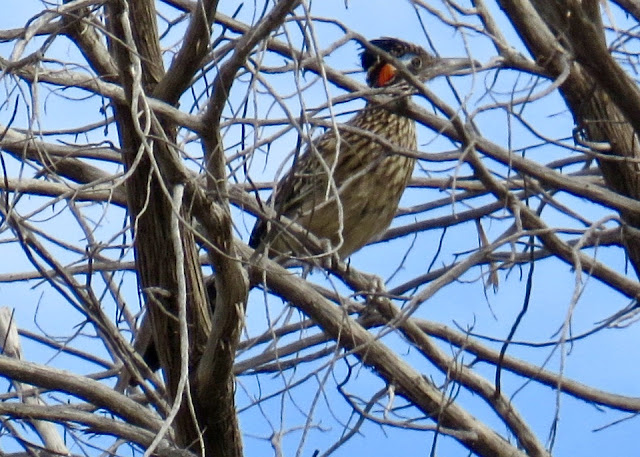Friday, August 7, 2015
Our summer monsoon season has delivered more dust and wind than rain, so with the sky overcast again this morning, I didn’t even think of rain.
Birder friend, Julie C. and I met and started birding at Granite Reef Recreation Area along the Lower Salt River at 6:00 a.m. Since this would be another SIT, we parked closer to the kayak and fishermen parking area so as to not disturb the birds too much in the picnic area where we would settle.
Julie had her chair; I carried a bucket with a nice rounded lid I had found online. It’s a handy way to carry gear and have a 360° option for sitting and following the sounds of birds.
Thunder and black clouds rolled over Red Mountain. Birds were fairly quiet with the exception of the early-rising Verdin who were as chipper as we were. A Ladder-backed Woodpecker whinnied a couple times from a distance and finally flew in from across Bush Highway.
A male Vermilion Flycatcher was busy catching insects in the air. A Black Phoebe showed up and tried to chase the Vermilion away. The Vermilion moved slightly to another branch but continued to fly-catch while the Black Phoebe stayed for half a minute before flying away.
Between thunder rumbles, Gambel’s Quail called from the east side of the rec area. We heard the sharp “peek . . . peek” of an Abert’s Towhee.
Several times, we heard a Brown-crested Flycatcher’s “whip” call followed by its rolling brrrrrrg, but it never flew into the mesquite picnic grove where we sat.
Although the marsh grasses were tall, I heard a couple Northern Rough-winged Swallows over the river. Julie heard some Mallards in between thunder moans.
Gila Woodpeckers began to show up around us. And, at about 6:30, the lazy Great-tailed Grackles woke up raucously in the reeds and flew out one by one to stake out their own space.
Dark clouds dropped lower over the picnic area. Jagged lightening struck the ground next to Red Mountain. It looked like the storm was not going to go around us. But, still no rain. We stayed put - briefly.
Best sighting there was a female Bullock’s Oriole feeding from one tree to another, looking very healthy with its yellow head showing a faint black eyeline that helps distinguish it from the female Hooded Oriole that also has a gray back and two white wing bars. The Bullock’s female has a pale yellowish breast and white belly and vent, while the female Hooded’s yellow throat and breast continue on down through its belly to its vent, showing much more yellow underneath than the Bullock’s.
When a lightening bolt landed on the far west side of the rec area, the immediate thunder clap rattled our teeth, so we got ourselves back to the car in a jiffy.
 |
| Faint rainbow |
Having been there just forty (40) minutes, we headed toward Coon Bluff, but it was raining hard as we drove east on Bush Highway so we continued on out to Butcher Jones where, when we arrived, the rain was finished; it was clear and sunny.
It’s amazing what we see while birding. We stayed in the car, parked parallel to the cove and muddy beach for the full 40 minutes of birding we did there.
In addition to female and juvenile Brown-headed Cowbirds around and on some of the wild horses there, we saw a small flock of apparent Pied-billed Grebes in the distance, a Great Blue Heron along the shoreline and American Coots closer to the beach.
Out in the water, we counted 8 swimmers doing big laps around the near and far buoys — for an estimated one mile swim per lap. The water didn’t look all that inviting but they seemed to be getting good exercise wearing bathing suits, bathing caps and water shoes.
Also present on the beach, in the marsh grasses and closer to us in the mesquite picnic area, we counted 16 wild horses.
After all the publicity about the US Forest Service wanting to roundup and eliminate the wild horses from this area, we counted 12 photographers out there with the horses “shooting” away. One man was running to get as close to the horses as possible for good shots. I was glad to see that when he spooked a band of horses over to the marsh reeds, they stood, across the inlet with heads in the tall grasses showing the photographer only their asses.
[The wild horses are on reprieve from the Forest Service’s initial attempt to round them up due to citizen activists who have followed the horses for years through the Salt River Wild Horse Management Group.]
Birds seen there and not mentioned above: European Starling, Great-tailed Grackle, Red-winged Blackbird, Gila Woodpecker, Ladder-backed Woodpecker, Northern Flicker, Verdin, Curve-billed Thrasher, Mourning Dove and Turkey Vulture.
Still not 8:00 a.m. when we pulled out of Butcher Jones, we stopped off at Saguaro Lake North. It was unbelievably quiet. Out by the dam, we couldn’t even find a cormorant. Nor, American Coots in close to the shore! A bunch of Mallard mutts hung around the boat ramps, but for waterfowl, that was it at that hour. Not even a sea gull to tantalize us.
We did see some desert birds: Black-throated Sparrow, Black-tailed Gnatcatcher, Black Phoebe, Verdin, Gila Woodpecker and Turkey Vultures.
As we drove past Coon Bluff and Granite Reef, it was still raining there. So, we finished birding at 8:20, and wrapped up our morning at Sunnyside Breakfast Lounge on North Power Road where Julie and I visited together for a while before heading back to our respective homes and future agendas.
There was no indication of any rain having fallen this morning in my neighborhood!














































